The Northern Leopard Frog is a frog species throughout North America, from the Canadian provinces to the central United States. It is named after its distinctive spotted pattern, similar to that of a leopard.
And this pattern is camouflage, helping the frog blend in with its surroundings and avoid predators. These unique frogs have colors that range from light green to dark brown.
In addition to its appearance, the Northern Leopard Frog is known for its vocalizations, ranging from short, low grunts to a long, musical trill.
As with many amphibian species, Northern Leopard Frogs face several threats to their survival. These may include habitat loss, pollution, and disease. This makes studying and conserving the Northern Leopard frog ecology all the more critical.
The scientific name for the Northern Leopard Frog is Lithobates pipiens. It belongs to the family of Ranidae and the genus Lithobates. Other names of the Northern Leopard Frog include the Meadow frog or the Grass frog.
Studying and conserving Northern Leopard Frog populations cannot be overstated. As a keystone species in wetland ecosystems, Northern Leopard Frogs play a critical role in maintaining the health and balance of these delicate ecosystems.
This article aims to provide a comprehensive guide on the Northern Leopard Frog, including its physical characteristics, habitat, behavior, and conservation status.
Physical Characteristics

Here are the Northern Leopard Frog physical characteristics.
1. Size
The Northern Leopard Frogs are robust and can grow up to four inches long, with females generally larger than males. They have powerful, muscular hind legs that jump up to six feet in a single leap.
For weight, adult Northern Leopard Frogs typically weigh between 20-70 grams (0.7 to 2.5 ounces). The frog’s weight can vary depending on age, sex, and geographic location.
2. Coloration and Markings
Northern Leopard Frogs are typically green or brown, with irregular black spots covering their backs, legs, and sides. The spots are not always circular and can vary in shape and size.

- The belly is white with a yellowish tint and is often unspotted.
- The patterns of their spots are unique to each individual, making them easily identifiable.
- In addition to the typical green or brown coloration with black spots, some Northern Leopard Frogs exhibit different color morphs, including the Burnsi morph and the albino morph.
- The Burnsi morph is characterized by a lack of spots on their backs. This morph is named after the biologist Richard Burnsi, who studied the Northern Leopard Frog and discovered its unique coloration.
Albino Northern Leopard Frogs, on the other hand, lack melanin pigment in their skin, resulting in a lack of coloration and visible black spots. These individuals are rare and are highly vulnerable to predation due to their lack of camouflage.
3. Skin Texture
The skin of the Northern Leopard Frog is smooth and moist, which helps them to breathe through their skin. They also have distinct dorsolateral ridges, or “fins,” that run along both sides of their back.
These ridges are raised areas of skin that extend from the eyes to the hind legs and are paler in color than the rest of the frog’s body. The skin secretions of Northern Leopard Frogs have antimicrobial properties that help protect them from pathogens and predators.
4. Different Species
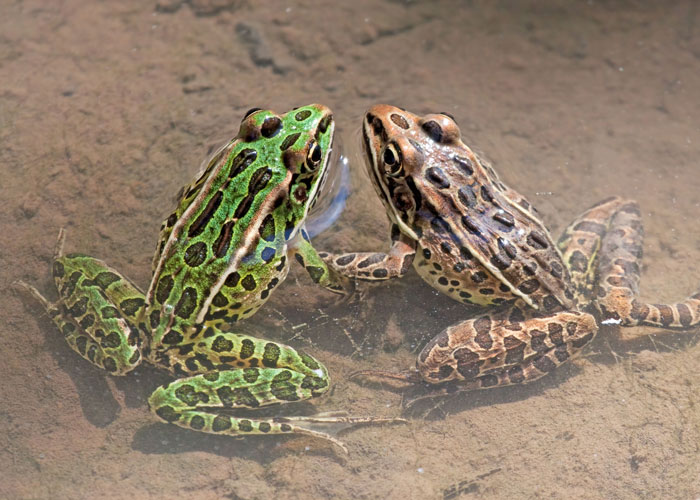
There are several Northern Leopard Frog species, including the following:
- Northern Leopard Frog (Lithobates pipiens)
- The Plains Leopard Frog (Lithobates blairi)
- The Southern Leopard Frog (Lithobates sphenocephalus)
- The Wood Frog (Lithobates sylvaticus)
The above species may differ slightly in their coloration and markings, as well as their range and habitat preferences.
5. Adaptations
Northern Leopard Frogs have several adaptations that help them survive in their habitats. They include:
- Their powerful hind legs allow them to jump quickly and efficiently. This helps during predator-prey interactions as they can escape and move through the dense vegetation common in wetlands.
- They also have webbed feet, which aid in swimming and navigating the water.
- The skin of Northern Leopard Frogs secretes mucus, which helps to keep their skin moist and protect them from pathogens in the water.
- Northern Leopard Frogs can also breathe through their skin, allowing them to take in oxygen even when submerged in water.
Habitat And Behavior
The Northern Leopard Frog habitat encompasses wetland ecosystems throughout much of North America, such as marshes, swamps, ponds, and streams.
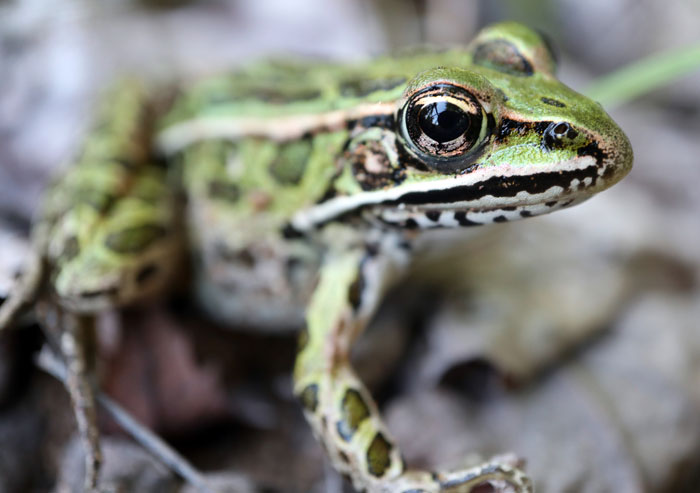
Geographical Distribution
Northern Leopard Frogs are distributed across much of North America, from the Rocky Mountains to the Atlantic Ocean. They can be found in the United States, Canada, and Mexico.
Elevation Range
Northern Leopard Frogs are most commonly found at elevations below 9,000 feet. The elevation range where these frogs are found is influenced by factors such as temperature, moisture, and the availability of suitable habitats.
Different behaviors exhibited by Northern Leopard Frogs
Understanding the Northern Leopard Frog behavior is critical for their survival in the wetland ecosystem. This section will provide an overview of the various behaviors displayed by these frogs.

Activity Patterns
Northern Leopard Frogs are primarily diurnal. They are active during the day and can also be active at night, especially during breeding.
Locomotion
Northern Leopard Frogs are excellent hoppers and can jump up to several feet to escape predators or move quickly across the land. They are also capable swimmers and climbers, which allows them to move easily between aquatic and terrestrial environments.
Social Structure
Northern Leopard Frogs are primarily solitary animals but may form loose groups during breeding. These groups are typically made up of males competing for access to females.
Communication
Males use distinctive calls to attract females during the breeding season, while females use chemical signals to indicate their readiness to mate.
Predators And Defense Mechanisms
Northern Leopard Frogs have various predators in the wetland ecosystem, including birds, snakes, raccoons, and fish. These frogs use several defense mechanisms to avoid being eaten, including camouflage, jumping, or swimming away from predators.
Role Of Northern Leopard Frogs In The Food Chain Of The Wetland Ecosystem
Northern Leopard Frogs serve as both predators and prey and contribute to the overall balance of the food chain. Adults primarily consume insects, spiders, and other small invertebrates. As predators, they help control populations of these smaller organisms in the wetland ecosystem.

At the same time, Northern Leopard Frogs serve as prey for various predators, including birds, snakes, raccoons, and fish.
Breeding Season
The breeding season for Northern Leopard Frogs typically occurs in the spring or early summer. This is when the water temperatures are warm enough for the eggs to develop. During this time, males will gather near water bodies and compete to access females.
Mating Rituals
Males use distinctive calls to attract females during the breeding season. They may also use displays to attract females, such as puffing up their throats or waving their forelimbs.
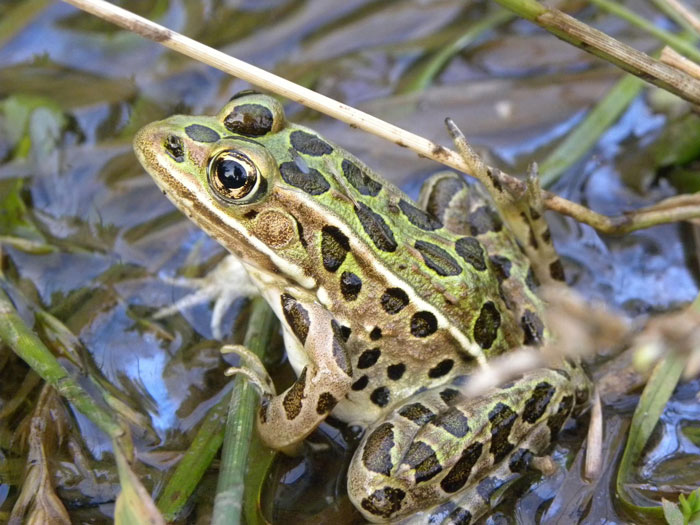
Once a male has attracted a female, they will engage in amplexus, a mating position where the male grasps the female’s waist with his forelimbs.
Fertilization Type
Northern Leopard Frogs use external fertilization. This means the female will lay her eggs in the water, and the male will release sperm to fertilize them. The fertilized eggs will then develop into tadpoles.
Egg-Laying Habits
Female Northern Leopard Frogs lay their eggs in clusters or masses, which can contain up to 4000 eggs. The eggs are typically attached to vegetation or other objects in the water.
Development Stages
After hatching from their eggs, Northern Leopard Frogs go through several stages of development. They start as tadpoles, which have gills and a tail for swimming. Over time, the tadpoles develop legs and lungs, and their tails shrink. Eventually, they undergo metamorphosis and become adult frogs.
Parental Care
Northern Leopard Frogs do not exhibit any parental care for their offspring. Once the eggs are laid, the adults will typically leave the area, and the tadpoles will be left to develop independently.
Diet

Northern Leopard Frogs are considered generalist feeders and will consume various prey items.
- Their diet consists primarily of insects, spiders, and other small invertebrates. However, they also eat small vertebrates such as other frogs, tadpoles, and occasionally small fish.
- Their foraging strategies vary depending on the availability of prey and their preferred habitat.
- Northern Leopard Frogs will hunt in aquatic habitats by sitting motionless and waiting for prey to come within range. They will then quickly extend their sticky tongue to catch the prey item, which they will swallow whole.
- On land, they will actively hunt and search for prey, often using their keen eyesight to locate potential food items.
- Northern Leopard Frogs are opportunistic feeders and will utilize available food sources. For example, they have been known to feed on carrion, which provides an easy and abundant source of nutrients.
- They may also eat plant material such as fruits and seeds, although this is much less common.
- Their diet can vary depending on the time of year, with a greater reliance on insects during the warmer months.
- But a greater consumption of invertebrates and vertebrates during the cooler months when insect populations are lower.
Overall, Northern Leopard Frogs play an essential role in the food web of the wetland ecosystem, acting as both predator and prey. By consuming various prey items, they help regulate the populations of other species in the ecosystem, contributing to its overall health and balance.
Conservation Status
The Northern Leopard Frog is classified as a “least concern” species on the IUCN Red List of Threatened Species. However, their populations have significantly declined in many areas. This has led to them being listed as a “species of special concern” in some regions of Canada and the United States.
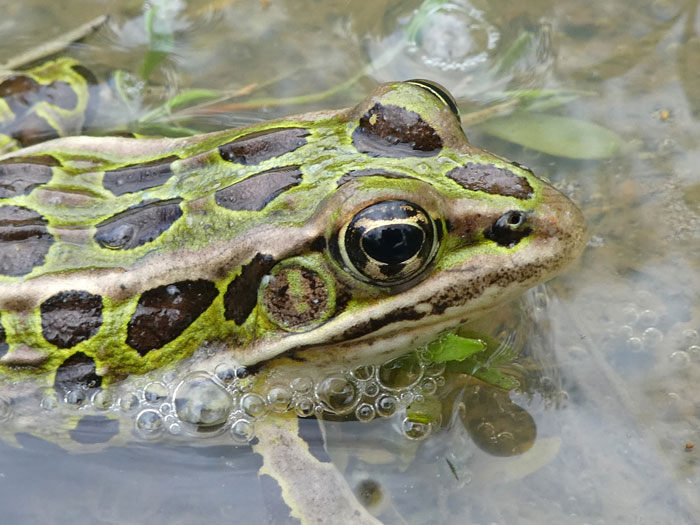
Threats Faced By The Northern Leopard Frog
Several threats these frogs face include:
1. Habitat loss
This encompasses habitat fragmentation, loss, and degradation. Wetland habitats are under threat from agriculture, urbanization, and industrial development. This leads to a decrease in available breeding and foraging areas, which can lead to population declines.
2. Pollution
Pesticides, herbicides, and other chemicals used in agriculture and industry can contaminate wetlands and impact the frog’s health and reproductive success.
3. Climate Change
This can alter breeding season timing and affect suitable habitats’ availability.
4. Disease
The most dreadful disease is chytridiomycosis. This disease can cause skin lesions, disrupt the frog’s electrolyte balance, and ultimately lead to death.
Conservation Efforts
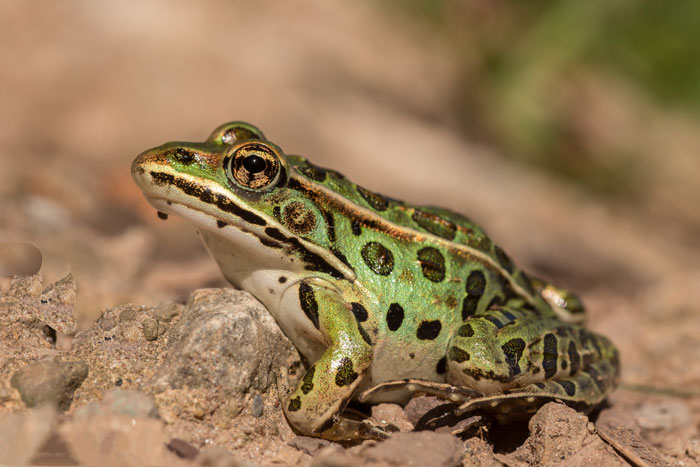
Conservation organizations are making efforts to protect these frog populations by doing the following:
1. Legal Protections
Examples of legal action are the Endangered Species Act in the United States and the Species at Risk Act in Canada. These acts help to regulate human activities that impact wetlands and their inhabitants.
2. Captive Breeding Programs
These programs have also been established to help maintain genetic diversity and increase population sizes. Restoration ecology projects are also crucial for providing suitable breeding and foraging habitats for Northern Leopard Frogs.
3. Population Monitoring Programs
These programs are essential for assessing the status of Northern Leopard Frog populations and detecting declines or changes in their distribution.
For example, the North American Amphibian Monitoring Program (NAAMP) is a citizen science project involving volunteers monitoring amphibian populations across the United States and Canada.
This program helps to identify areas where Northern Leopard Frogs are declining and prioritize conservation efforts accordingly.
Importance Of Conservation
Continued Northern Leopard frogs frog conservation efforts are critical for the survival of these and other wetland species. Wetlands are essential ecosystems that provide numerous benefits, such as flood control, water filtration, and carbon storage.
They also support diverse plant and animal communities. By protecting wetlands and the species that depend on them, we can help to ensure that these critical ecological services are maintained for future generations.
Interesting Facts

Here are some interesting facts about Northern Leopard Frogs.
- Northern Leopard Frogs are named for their unique spotted pattern, which resembles that of a leopard.
- Northern Leopard Frogs can hibernate underwater during the winter by absorbing oxygen through their skin.
- Their vocalizations are unique, and each frog has a distinct call that helps them find mates.
- They have a relatively short lifespan, typically 2-4 years in the wild.
- Females are somewhat larger than males.
Conclusion
Northern Leopard Frogs are fascinating amphibians with distinct physical characteristics and intriguing behaviors. Their distinctive spotted pattern and powerful legs make them a fascinating subject of study for animal enthusiasts, students, and research institutions.
Northern Leopard Frogs face numerous threats, including habitat loss, pollution, and disease. That is why it is critical to consider trying to protect available frog habitats.
Continued research is required to ensure the survival of Northern Leopard Frogs and other species in the wetland ecosystem. Thus, numerous resources are available to those interested in learning about Northern Leopard Frogs, including scientific journals, books, and online articles.

Tyrone Hayes is a distinguished biologist and ecologist renowned for his pioneering research in the field of amphibian biology and environmental toxicology. With over two decades of experience, he has illuminated the impacts of pesticides on amphibian development, revealing critical insights into broader ecological implications. Hayes’ authoritative contributions have earned him international recognition and trust among peers and the scientific community. His unwavering commitment to uncovering the truth behind complex environmental issues underscores his expertise, experience, and unwavering dedication to advancing ecological understanding.
